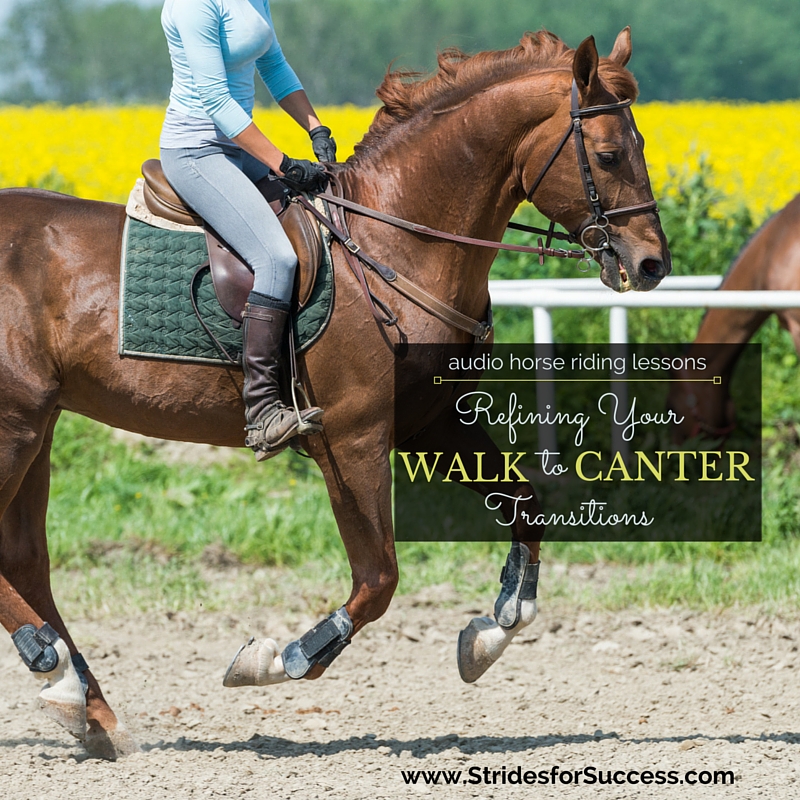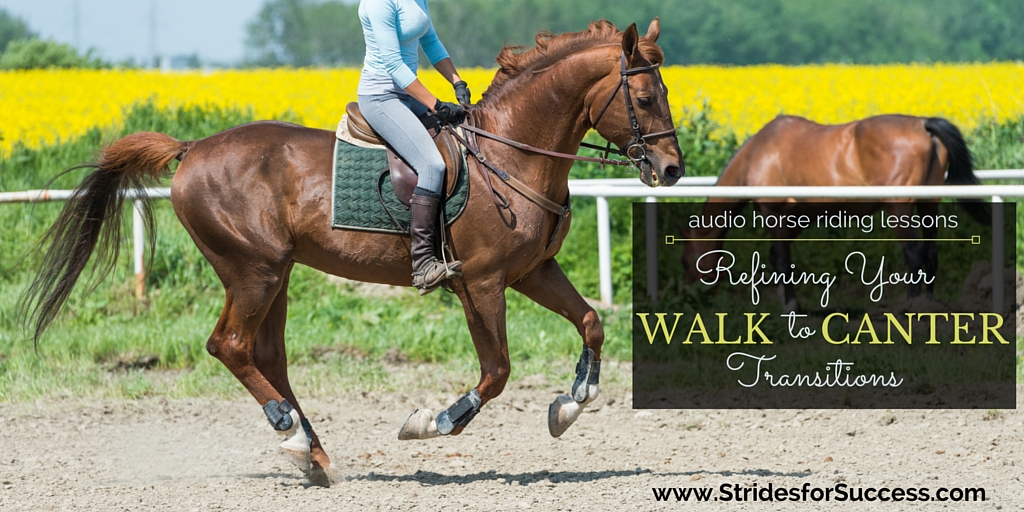Do you find that when asking your horse for canter, you tend to ‘over do’ some aspects of your aids? Perhaps you throw your reins at your horse, or you try to ‘push’ too much with your seat or upper body… You are shoving and bumping about in the saddle!
And when your horse eventually ‘strikes’ the canter, you are so far from where you want to be position-wise, that it takes the first 5 to 10 strides just to get your limbs back listening to you. This is before you can even begin to turn your mind to the quality of the canter happening underneath you.
Why Introduce the Walk to Canter
Assuming you have a fairly independent seat. And that your horse is schooled and developed enough to understand the aids to canter and then carry himself in the canter… I suggest beginning to improve your canter by introducing walk to canter into your schooling routine.

Refining your walk to canter is a fantastic exercise for both horse and rider. It will help you improve the actual canter itself. This is due to the fact that you arrive at the transition more prepared, more organized, and less hurried.
It helps your horse by strengthening him and helping him to understand more subtle aids, due to you being more organized with giving them!
Your Horse’s Canter
Before you begin it is important you understand the canter itself and the aids to ask your horse to canter… You probably know that your horse ‘leads’ with one of his front legs when he canters.
Depending on which front leg you want him to lead with, you will ask him to strike off with the opposite back leg.
Canter has a three-time beat, so using the left back leg as his ‘striking leg’ he will then move his inside back leg (right back leg) together with his outside front leg (left front leg), meaning the diagonal pair move together. The third beat comes from the leading front leg (in this case the right front leg). Then there is a short moment of suspension before the outside hind leg touches down again and the sequence begins over.
Collection in the Walk
Preparation is everything, so establishing a good quality walk is essential. Ideally, you want to have a little collection in your walk, which you can achieve by applying lots of half halts throughout the ride. Think of creating energy with your legs and then containing it or storing it, until needed, with your hands.
The walk must not lose its forward momentum and your horse must not become ‘sticky’ in the walk, which often happens when riders are trying to collect things up. Keep in mind that the half halt is only held for a split second; then released. Rather up the quantity of the half halts, than increasing the length you hold them for.
Timing Your Aids
Regarding your aids and applying them… I recommend you begin by becoming aware of what leg is stepping down, onto the ground, at any given time underneath you.
The reason this is important is that you need to apply your aids to ask for the canter either just before or when the outside hind leg is busy moving forward, coming under the horse, and before he ‘steps down’ onto it.
When I am teaching in the arena, I ask my riders from very early in their riding journeys to begin identifying the different legs underneath. We do this them by saying ‘Now…’ ‘Now…’ ‘Now…’ ‘Now…’ when a particular leg is ‘touching down’.
It allows them to become familiar with the rhythm and sequence of the footfalls, so that they can then, while they are still repeating’ Now’, begin noticing how it ‘feels’ when that hind leg is beginning to lift up to moving forward and underneath.
Next time you are in the saddle, do this exercise. Feel how, when his inside back leg is moving forward, and this is nice and easy to feel in walk, your corresponding seatbone is ‘down’. This is due to your horse having to swing his barrel slightly to the other side in order to make room for that leg to come underneath him.
Your Seat Bones
So, when the left back leg is coming forwards, your left seatbone will be slightly lower and also moving forwards. While this is happening your right seat bone will be slightly raised and will feel as though it is ‘sliding’ back.
Once your horse puts his right back hoof on the ground, you will feel your right seat bone raise up. It will begin to feel like it is sliding backward, as your horse moves over the right back hoof. While this is happening, your left seatbone will be lowered slightly. And sliding forwards, as your horse’s left back leg moves underneath him, preparing to bear the weight again.
You will feel that as your inside seatbone is at its most forward point, your outside seatbone will be ‘back’ slightly and higher that the inside. Then, as the inside hind leg touches the ground, and your horse begins to lift his outside hind leg forward to put down underneath him, your outside seat bone will ‘drop’ and begin to move forward. This is, again, due to the shift in your horse’s barrel to make way for the leg coming underneath him.
Asking for the Canter
Now, I personally think the exact time to ask for the transition depends a lot on your horse and how responsive he is to your aids
If he is a little ‘laid back’, you may have to ask just before your inside seatbone is at its most forward position. So before it begins to move back ‘up’ and back. However, if your horse is a little sensitive, or quite responsive, it may work better for you to ask just as your outside seatbone begins to ‘dip’ and move forward again.
Knowing exactly when to ask comes down to ‘feel’. And, luckily, this can be learned through time and consistent practice in the saddle. There is a blog post and audio lesson on ‘Improving Your Feel in the Saddle’ HERE >>
Often, we ask too late. Or at the incorrect time! And the result is either our horse trots, because he cannot get his legs into the sequence for canter. Or he begins to canter with his front legs first, not striking off with the outside hind. This is not correct, and you will almost feel that your horse skips. If this happens, bring him back to walk and try again.
Be Clear About What You Want
When setting up your first walk to canter transition, have a clear idea in your mind on how you are going to ask for canter. Focus your attention on establishing a good, active walk with lots of energy. Become clear on how you are going to apply your aids, and when.
Your seat is vitally important in asking for the canter. Often you hear of using your seat to ‘scoop’ your horse up into the canter. This cannot happen unless you are truly carrying your upper body. And you ask for the transition at the correct time.
Your inside leg will remain on the girth, your outside leg will ‘swing’ back. This is to indicate to your horse to strike with the outside hind leg and your hands will follow the movement when it happens.
Using a Circle to Help
Start riding a 20 meter circle, which will help you initially as your horse will already be positioned with a bend to the inside. This will increase your chance of a clean strike on the correct lead. You will be working with your horse rather than against it.
Resist the temptation to lean or push. The canter is asked for with your seat first and foremost. Your legs and hands must also do their job in both indicating and allowing your horse to canter
The transition should be clean. If your horse begins to rush in the walk, trots or jogs a little when asked, immediately bring him back to walk. From there, work on preparing a good transition all over again. Begin with the walk and half halts.
Quality of Walk to Canter
Keep in mind that the quality of the transition can only be as good as the gait leading up to it. So set your intention on an achieving an active, forward walk
Once you have performed the walk to canter transition, remember to reward your horse with a kind word and a softening of the inside rein. Let him know that he has indeed carried out what you asked. If you are late to reward, he may not know for future reference what you are looking for.
Continue with the canter for 15 to 20 strides. Pay attention to how quickly it takes you to establish a rhythm this time. Have you managed to keep your upper body light in the saddle? Is your lower leg where it should be? Are you following your horse with your pelvis and hands?
Continue to practice this on both reins and notice if one lead is easier to achieve than the other. Also, keep your attention on how long it takes you to feel ‘in control’ of the canter. And, if it happens somewhat sooner than if you canter through trot.
Happy Riding
Lorna
And, finally, if you would like to go further with your riding I highly suggest you give my free training series a go…Find the Gaps in Your Horses Training using this free audio series available for you to listen to in a private podcast feed – so just as easy as listening to the Daily STrides Podcast :) You can sign up for free HERE or visit https://stridesforsuccess.com/free
Additional Posts on this Topic
Get Support & Guidance in Your Riding
-
-
- Free Resource:- Find the Gaps in Your Horses Training
- Connection; the Online Membership for Equestrians
- Lunging for Riding – a 4-week program that gets results
- Groundwork for Riding – 4-week program (no arena required ;) )
- Daily Strides Premium Newsletter
- Online Community for Equestrian focusing on Planning and Mindset
- Equestrian Virtual Lounge Online Community
-
Riding a Smooth & Timely Walk to Canter Transition
Some exercises can have a ripple effect all through our riding when we dedicate some time and energy to making them better. I believe that the walk to canter is one of those exercises and I am excited to help you master the transition this month with your horse.
This group of episodes is available for you to begin working with today, inside of Connection. They are suitable for all horses and riders who are able to canter. They will help you both become clearer on the aids, and more focused on timing and its importance. And more balanced and responsive as well.


2 Comments
Emma Randels
September 3, 2015 5:55 amI really love doing the walk to canter transitions. That usually ends up getting us on the same page if we weren’t already. I feel it syncs both the horse and I together, again, if we aren’t already. The tricky ones are the canter to walk transitions though! =)
stridesforsuccess
September 3, 2015 6:29 amHi Emma, agree totally with what you said and love the idea of ‘syncing’ horse and rider :)
Canter to walk is on the list of topic coming up soon… And I agree, much more difficult to get right!